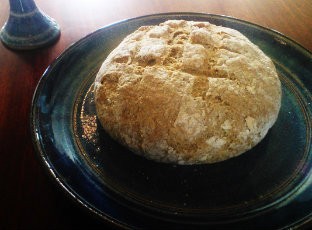The quest for a common loaf

“Take and eat,” Jesus said, passing the bread around. And everybody did—except for Philip, who went away hungry, for he was allergic to gluten.
Actually, there’s no evidence to suggest that any of the disciples suffered from a wheat allergy. But lots of Christians do today. This makes it challenging to come up with communion elements that everyone in a given Christian community can enjoy together.
Yes, there are other ways you can handle the issue. You can have a little plate of gluten-free wafers on the side for those who need them. But this just doesn’t match the extravagant spirit of the meal itself—those forlorn little wafers for the complicated ones in the shadow of the big, crusty loaf blessed and broken for everyone else.
For a couple years now, those of us involved in the chapel program at Pittsburgh Theological Seminary—where I teach—have been looking for a truly common loaf. We celebrate the Lord’s Supper in chapel every Thursday classes are in session, and we have regular attendees who cannot eat anything that contains gluten. We have tried many a gluten-free loaf, in search of that perfect combination of breakability and taste.
There have been some real disasters along the way. There was the loaf that was, yes, gluten-free, but exploded into a fine powder when broken. Each worshipper left behind a trail of bread crumbs, like Hansel and Gretel.
There was the one that didn’t show its true colors until a hunk of it was dipped into the cup of wine, at which point it promptly dissolved. What are you supposed to do as you watch your piece of bread vanish beneath the waves, never to be heard from again? The body of Christ, sunken for you? All you could do was choke out a mournful “Amen” and head back to your seat.
Finally there was the loaf that worked beautifully for the gluten-intolerant members of our community, but it did so in part by adding a hearty dose of potato starch—thus rendering it off limits for another member of our community, who can’t eat nightshades.
Back to the big, crusty loaf and the lonely wafers.
The turning point came a few months ago, when one of our M.Div. students—Charissa Howe—found a recipe for gluten-free, nightshade-free, nut-free, vegan bread at the Whole Life Nutrition Kitchen site and did some tweaking. The final version calls for some uncommon ingredients: chia seeds, psyllium husks and garbanzo fava flour, to name a few. But it has a wonderful taste and texture, and it does not explode, crumble or dissolve into the cup.
In the beginning, four people from our seminary community volunteered to bake this new bread for our Thursday chapel service each week, passing the basket of unusual ingredients around. These days that number has expanded to about ten adventurous souls.
Now each Thursday when we come into chapel, we take a good look at that uncommon, common loaf waiting there on the table—and we remember the bumps along the way. We give thanks for the hands that prepared this bread, we marvel at its unexpected ingredients, and we delight that all can now eat with relish from the same extravagant loaf.
The recipe is below.
———
Communion Bread (gluten-free, nightshade-free, nut-free and vegan)
Ingredients:
2½ cups warm water (105 to 110 degrees F)
2¼ teaspoons active dry yeast (1 package)
1 teaspoon honey
2 tablespoons extra virgin olive oil
2 tablespoons maple syrup
1/3 cup ground chia seeds or 1/3 cup ground poppy and sesame seeds
1/3 cup whole psyllium husks
1 cup garbanzo fava flour
1 cup tapioca flour
½ cup sweet rice flour
½ cup cornmeal
1½ teaspoons sea salt
Put the warm water in a bowl. Add the yeast and honey and whisk together. Let rest for 5–10 minutes to activate the yeast.
While the yeast is activating, mix the dry ingredients together in a large bowl.
After the yeast is ready, whisk the olive oil, maple syrup, ground chia or poppy/sesame seeds, and psyllium husks into the water-yeast mixture. Let stand for just 2–3 minutes. Whisk again.
Pour the wet ingredients into the dry ingredients and mix with a wooden spoon until thick. Then knead the dough on a floured wooden board, adding the flours a little at a time, until the dough stays together and is just slightly sticky. Form the dough into a ball, put in the large bowl, and cover with a damp towel. Put it in a warm place to rise.
After the dough has risen, put a pizza stone in the oven and preheat to 400 degrees. Place a pan of water on the bottom rack of the oven.
Punch down the dough and return it to the floured wooden board. Knead for one minute, then form it into a round ball and place it on a piece of parchment paper. Use a sharp knife to cut a tic-tac-toe pattern on the top, then drizzle with additional olive oil. Let it continue to rise for about 30 minutes while the oven/stone are preheating.
Use the parchment paper to place the risen loaf on the pizza stone in the over. Bake for 40 minutes. Remove from the oven and cool for about an hour.





